Chang, Zong, Zongzi… they all mean 1 thing; glutinous rice with yummylicious fillings wrapped in bamboo/lotus/banana leaves. Chang is eaten on the 5th day of the 5th Lunar Month which is today in fact, 16th June 2010. 🙂
First I need to clarify something. My grandma is not a Nyonya but she learned how to make Nyonya Chang from her friend who is a Melaka (Malacca) Nyonya. Aunty Poh Poh, that was what we used to call her. May God rest her soul.

And now my sister is learning how to make Nyonya Chang based on my grandma’s memory recollection. This is her 3rd attempt in 3 years and I must say her Nyonya rice dumplings are getting better. According to my sister making chang is actually quite simple. The hardest part is the preparation of ingredients.
Preparation of rice dumplings begins a day before.
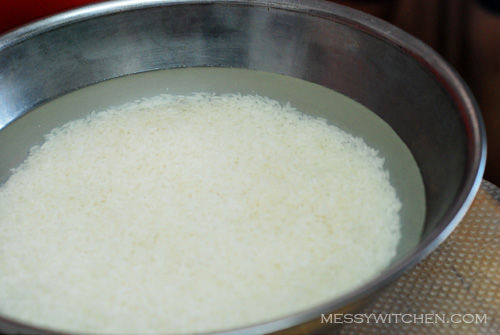
Soak glutinous rice overnight.
Note: If you want to have the indigo blue coloring on the rice, add 2 tablespoon of the coloring (extracted from the butterfly pea flower) into 150g of rice (from the 500g of glutinous rice). Soak overnight.
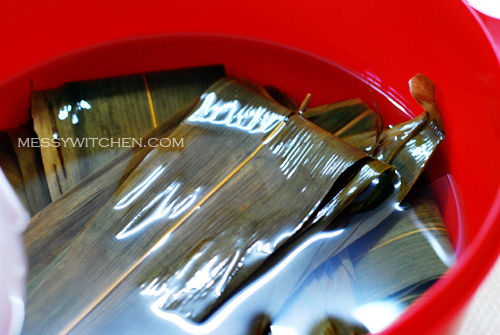
Soak bamboo leaves & bamboo or reed strings (not in picture) in cold water overnight. Rinse leaves and strings before using.
Also, soak 6-8 pieces of Chinese mushroom overnight.
On the day of Nyonya Chang making:
Rinse the soaked glutinous rice before cooking.

Bring water to a boil in a wok/steamer. Steam glutinous rice until cook.
Set aside.
Nyonya Chang Filling:
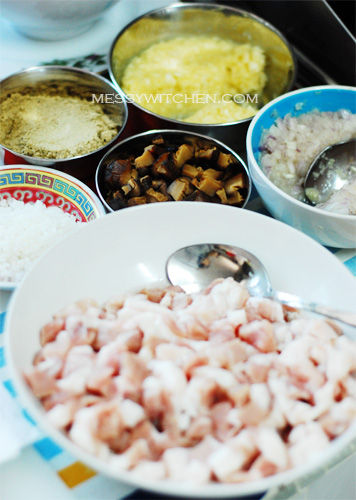
Clockwise L-R: chopped candied winter melon, pepper, chopped garlic, chopped shallots & pork belly
Middle: chopped Chinese mushroom
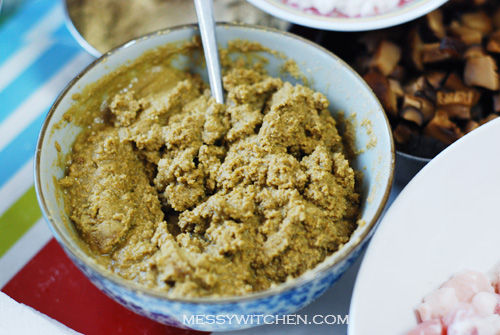
Combine aniseed and coriander powder into a bowl and add some water to make into a paste.
Let’s cook the Nyonya filling:
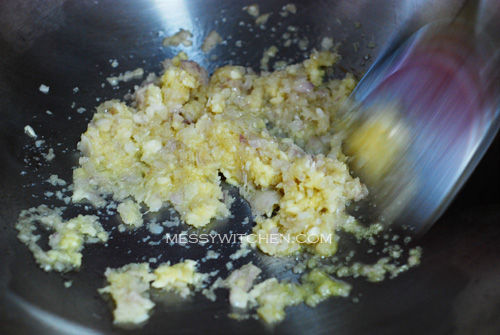
Add cooking oil in the wok.
Stir-fry shallots & garlic until fragrant.

Add aniseed & coriander paste to the wok and saute until fragrant.
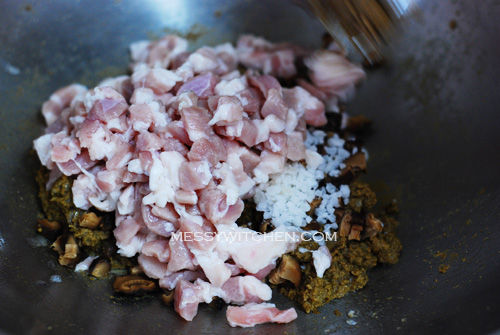
Next add pork belly, winter melon and Chinese Mushroom.
Stir well until cooked.
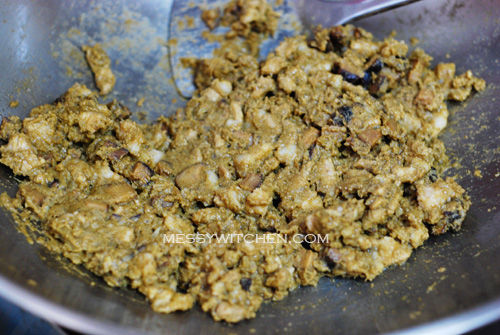
Meantime add pepper, sugar and salt to taste.
Do you know why we add sugar and winter melon into Nyonya Chang?
Nyonya Chang in Hokkien is called Puah Kiam Ti Chang which translate into sweet & salty rice dumplings.
Here’s the cooked Nyonya filling…
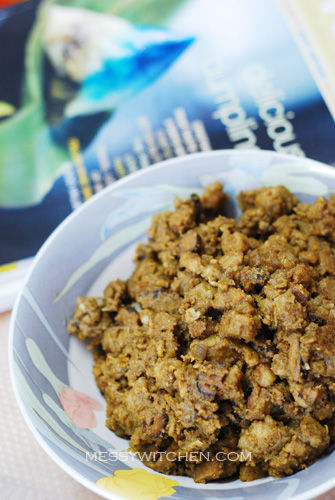
The book in the background is for reference. Haha
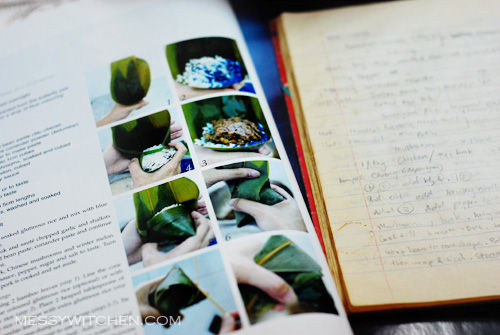
Grandma’s recipe on the right and Flavors magazine on the left.
Ok now we’re ready to wrap chang.
I’m going to show you how to wrap chang with step by step pictures:
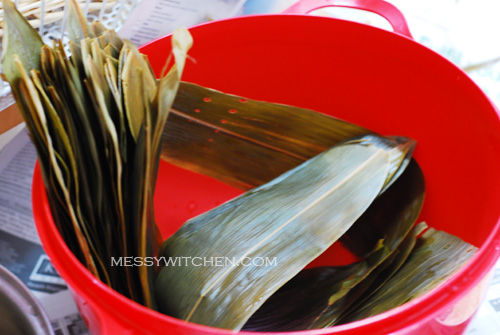
Soaked, cleaned and wiped dry bamboo leaves.
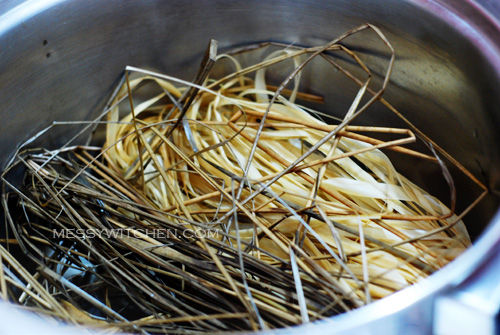
Soaked & rinsed bamboo and reed strings.
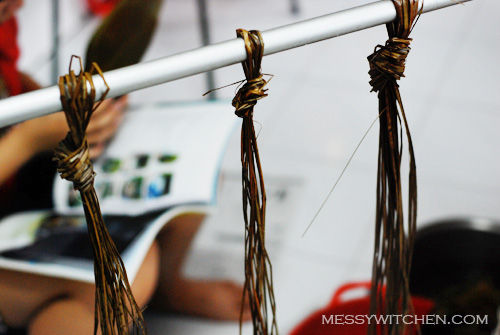
Take a handful of strings and tie it into a knot passing through a long rod like the picture above.

Have all your ingredients ready.
There’s the bamboo leaves and strings, a bowl of water (in case the rice become too sticky), Nyonya filling, cooked glutinous rice and pandan leaves (cut into 3cm length).
First thing first, overlap 2 bamboo leaves and fold into a cone.
Then follow the picture guides below. Click for larger view.

Clockwise, from top left.
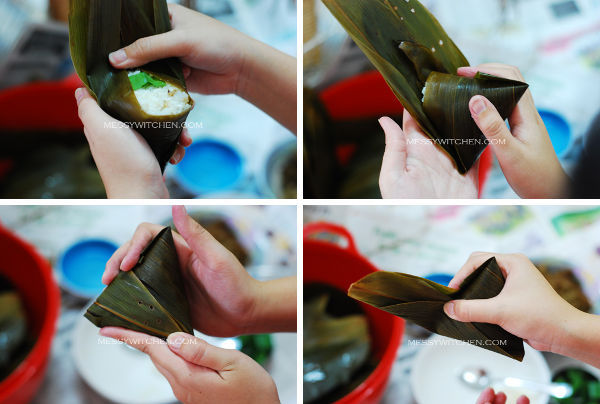
Clockwise, from top left.

Tie the wrapped chang with bamboo string twice. That’s it!

Here are the finished changs.
We actually make another bak chang flavor (soy sauce version). That’s why we have many bundles. Haha
Steam dumplings over boiling water in a wok/steamer for 30 minutes.

Nyonya chang on the left and soy sauce chang on the right.
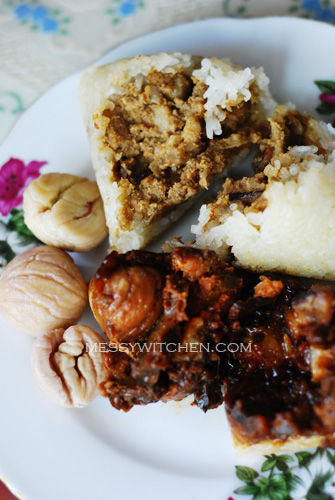
Chang is best eaten hot. Remember to finish your meal with a cup of hot Chinese tea ya. BURPP!!!
Grandma’s Nyonya Chang Rice Dumplings Recipe
Yields about 15 dumplings
500g glutinous rice, soaked overnight
30 dried bamboo leaves, soaked overnight, wiped dry
15 bamboo/reed strings, soaked overnight
Nyonya filling
1 bowl (Chinese soup bowl) of shallot, finely sliced
1 quarter bowl of garlic, finely sliced
30-50g candied winter melon
5-6 piece Chinese mushroom, soaked overnight, sliced
500g pork trotter (tui bak)/belly pork
5-6 heap tablespoons coriander powder
1 heap tablespoon aniseed powder
Add both together with water to become paste
Pepper, sugar and salt to taste
2 tablespoons cooking oil
2-3 pandan leaves, cut into 3cm length
Refer step by step pictures above for the method.
Happy Dumpling making!




33 Comments
That’s the only kind of “choong” my grandma and mom would make. They are still the best kind to me. Must be because I have been eating them since I was able to eat them till I left home. THe prepping of the ings and plaiting the top part of the strings were the most pain for us kids back then. I guess coz my grandma was so picky…she typical Nyonya, can’t help it..the dicing of the meat, winter melon all have to be same size!
Hi Dawn, wah all have to be same size? *pengsan* My great grandma was the bak chang making pro in the family. I remember we kids used to gathered around and help but I have no knowledge of making them. Only vague memory which I will treasure forever.
Great step by step method and lovely images,….thanks for sharing…
You’re welcome. Thanks for stopping by. 🙂
Hi Che Cheh,
Really miss the nyonya chang especially when i am in Australia and no way we can find it. Yesterday was the day to eat chang and i was so sad that I couldnt have it but now with your grandma recipe me so going to try it this weekend. A big thanks for sharing.
Hi Judy, feel free to add/subtract ingredients to cater to your taste buds. Hope you like it. 🙂
[…] http://messywitchen.com/how-to/grandmas-nyonya-chang-rice-dumplings-step-by-step-pictures-on-how-to-… […]
Hi Che Cheh,
I just learnt how to wrap chang from my cousin and was looking for another recipe – that’s how I stumbled on your site. I noticed you say to put sugar as needed. My cousin put in a LOT of sugar – it looked like more than 1 cup – and I got such a shock. She said that boiling in the water dilutes the taste of the filling! When we tried her chang, it was a bit tasteless I must admit, despite the huge amount of sugar. But I don’t want to increase the sugar even more. So my question is how come you don’t seem to use a lot of sugar. I am trying to cut down on white sugar and would be happy if I don’t have to put in any at all. Also, your rice is precooked whereas my cousin used raw rice. Wouldn’t this make filling the chang a lot more sticky and messy? I’d like to hear your thoughts/experience on this.
Hi Fran, sorry for the late reply. I had to ask my sister about your questions as she was the one making it.
My sister cook the rice first because this way is easier. Yes your cousin is right, boiling chang can dilute the filling taste if not done properly (e.g. chang being tied loosely). Make sure you press down to compress chang before wrapping. Did you add salt to the boiling water? The correct way is to add salt to the boiling water. Once done, hang chang to drain excess water.
As long as you season the fillings properly you don’t need to use lots of sugar. Just season the fillings according to your taste.
If you’re afraid of sticky, just pat your hand with some water. The sticky rice won’t stick to your hand then.
Hope this helps.
Thanks for your reply. I will try to remember to come back and let you know my results when I get around to making it. I prefer your version with the cooked rice. My first time, I was really bad at wrapping the chang! 🙁
Welcome. I had a tough time wrapping chang as well. 😛
I am keen to try making the nyonya chang. My problem is, I am living in Sabah and the people here are predominantly Sabahans or Malays. Can you please tell me how to say “aniseed” and “coriander poder” in Bahasa Melayu/Malaysia? I need to converse in this language when sourcing for all the ingredients.
Am looking forward to your reply.
Thanks!!
Hi Maryann,
Aniseed is jintan manis, coriander powder is serbuk ketumbar.
You can find the translation easily on the net.
So delicious so well done?
Thanks for sharing.
May I have a copy by email please
Thanks.
Hi Jenny, it’s not bad for us. The recipe still can be improved where you see fit.
You can copy the above post. I don’t email recipe. Sorry.
Hi,
Chance upon your blog as i was looking for some Nonya Dumpling recipe. When you said steam the glutinous rice till cooked, do you actually add any water into rice? 🙂
Hi Allison, no I don’t add water into the rice.
Hi Che-Cheh,
Thank you for clearing my queries! Will try them out soon! 🙂
Welcome Allison 🙂
Thank you for your most detailed, step-by-step instruction on how to do the Nyonya dumplings. It is easy to understand and the sequence of preparation of the dumplings is just right for any new comer or beginner.
Hi Stephen, you’re welcome. 🙂
Loving this recipe. However, where do I find Aniseed and Coriander powder in Malaysia? Would you have a picture of it “uncooked”, so that I can go in search of it. Thanks in advance
Hi Pearly, you can find coriander powder at Indian grocery shop, hypermarket, supermarket. Just look for the name. As for aniseed powder, you can try Chang Thung.
Thank you in advance Che-Cheh. I found both in Tesco and so happy to have seen them.
Welcome 😉
Is there a link to your soy sauce bak chang? Thanks
Hi Frank, I didn’t post the soy sauce bak chang recipe.
How much water to rice ratio when you steam it? Can I dye the rice after I steamed it? Thanks
For steaming, you don’t put the rice inside the water. The water should be enough so not to dry up while steaming. Water should be about 1/2 to 3/4 of your steaming container. As for the dye, put it before steaming the rice.
Hi Che Cheh, I was searching for a faster method to cook the dumpling. so far, you are the only one who cooked the rice first.
Isn’t it difficult to wrap the rice when it is sticky after cooked?
So the process of the rice goes like this. Soak rice –> Steam until rice is cooked (how many minutes?) –> Wrapping –> Steam for another 30 mins ?
Thank you!
Hi Frank, yup there are two methods. If you find it troublesome, you can use uncooked rice to wrap the chang straight away. We found it OK to wrap the cooked rice, not really sticky. Steam the rice for about 30 minutes +/-. Test the rice to check if it’s cooked.
Hi Che Cheh, can I clarify if aniseed powder is the same as fennel powder because that’s what comes up if I search jintan manis? What about grounded star anise? Thanks!
Hi Yan Ting, aniseed is different from fennel or star anise. Its Malay name if I’m not mistaken is adas manis. If you can’t find aniseed, you can substitute with fennel.